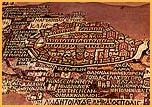|
The Holy Land: Jerusalem
Among the many holy sites in Palestine connected
with the life of Jesus,  Jerusalem
was to become a major centre for Christian pilgrims, with
an established circuit of sites, numerous churches, shrines,
relics, hospices, and thousands of visitors. Its most important
church was the Church of the Holy Sepulcher, built by
Constantine I
between 326 and 335, on the traditional site of the crucifixion
and burial of Jesus. The monumental complex lay between the
cardo and Christian's
Street, in the north-west quarter of the city. It comprised
an
atrium, a
basilica, a
second colonnaded atrium (also known as the Holy Garden),
and the Anastasis (Resurrection) rotunda, aligned east to
west. Three entrances lead from the atrium into the basilica.
The latter had four rows of columns and a large
apse pointing
west, towards the Sepulcher, rather than east, as it was customary
in later churches. The Anastasis rotunda was a semi-circular
covered structure (diam. 35 m) with three apses. In its centre,
a circle of twelwe columns in groups of three each, alternating
with four pairs of square piers, surrounded the Sepulcher. Jerusalem
was to become a major centre for Christian pilgrims, with
an established circuit of sites, numerous churches, shrines,
relics, hospices, and thousands of visitors. Its most important
church was the Church of the Holy Sepulcher, built by
Constantine I
between 326 and 335, on the traditional site of the crucifixion
and burial of Jesus. The monumental complex lay between the
cardo and Christian's
Street, in the north-west quarter of the city. It comprised
an
atrium, a
basilica, a
second colonnaded atrium (also known as the Holy Garden),
and the Anastasis (Resurrection) rotunda, aligned east to
west. Three entrances lead from the atrium into the basilica.
The latter had four rows of columns and a large
apse pointing
west, towards the Sepulcher, rather than east, as it was customary
in later churches. The Anastasis rotunda was a semi-circular
covered structure (diam. 35 m) with three apses. In its centre,
a circle of twelwe columns in groups of three each, alternating
with four pairs of square piers, surrounded the Sepulcher.
 The
Sepulcher itself was marked by a hewn rock, surmounted by
an edicule, in which oil lamps burned day and night. The oil
from these lamps was believed to have miraculous healing capacities
and was collected in small lead flascs
(ampullae),
in order to be sold to the worshipers. In the south-east corner
of the colonnaded atrium stood the rock of Golgotha, enclosed
in a small structure supported by four piers. The
Sepulcher itself was marked by a hewn rock, surmounted by
an edicule, in which oil lamps burned day and night. The oil
from these lamps was believed to have miraculous healing capacities
and was collected in small lead flascs
(ampullae),
in order to be sold to the worshipers. In the south-east corner
of the colonnaded atrium stood the rock of Golgotha, enclosed
in a small structure supported by four piers.
Constantine also donated a church on the Olive Mount,
east of Jerusalem. Several other churches were erected in
the fifth century, among them the Church of Holy Zion on Mount
Zion, and the Church of the Ascension on the Olive Mount.
Empress
Eudocia invested
considerable funds in the city's development from the early
440s until her death in 460. A martyrium for St Stephen, and
an extension of the city wall on Mount Zion, were constructed
at her behest. Under Justinian, building projects such as
the Nea (New) Church and the continuation of the
cardo were undertaken. The
Nea, a vast
basilica dedicated
to the Virgin, was inaugurated in 543. The actual remains
of the church measure roughly a hundred meters in length and
fifty two meters in width, making it the largest known basilica
in Palestine. According to
Prokopios, the
church was surrounded by
porticoes and
preceded by a large colonnaded
atrium, a circular
courtyard and a gate. Other litterary sources mention a monastery,
a hostel, a hospital and a library, and excavations have revealed
a large water reservoir under the church foundations. The
Nea was indeed a complex of monumental proportions, the execution
of which was entrusted to Theodoros an architect from Constantinople.
|